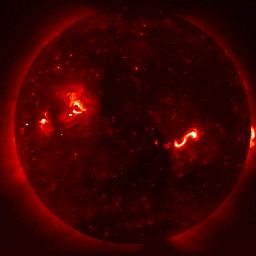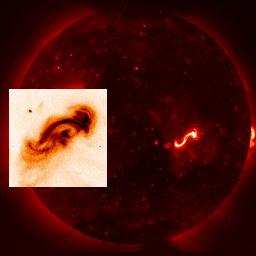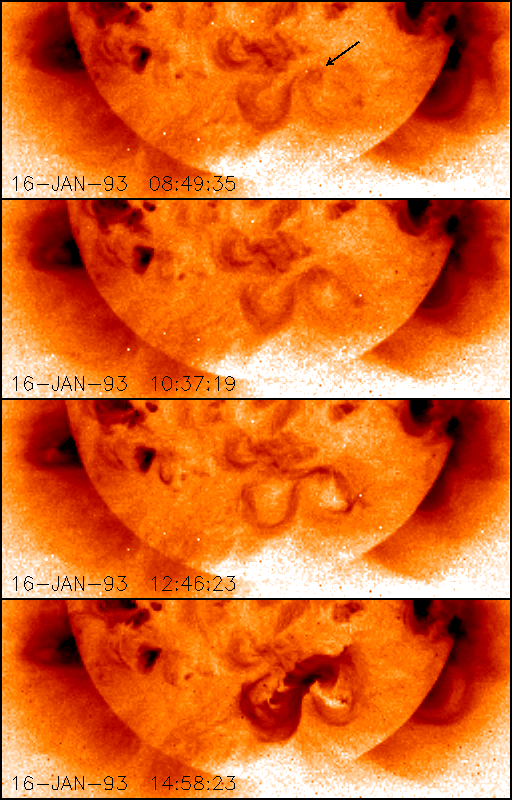 |
MSU Solar Physics Group |  |
 |
MSU Solar Physics Group |  |
Notice: The full text of our May 2007 Press Release is linked here.

Summary of the New Results
Peering into the formation of 'storm clouds'
Coronal mass ejections, or CMEs, are violent discharges of material from the Sun's outer atmosphere. The ejected material can travel at speeds of up to a million miles per hour. If this flow of charged particles and embedded magnetic field collides with Earth, it can dramatically disrupt Earth's geomagnetic field and ionosphere. Because of the potential effects of Earth-directed CMEs, one would like to have tools with which to predict CME occurrence. A feature that has been found to be common to many eruptions is an "S" shaped structure of the CME-producing solar active region before the eruption takes place. The "S" shape -- or sigmoid -- can be seen in the image at right. In this full-Sun X-ray image, from the Hinode X-Ray Telescope (XRT), the bright sigmoid is observed on the right-hand side of the solar disk, just at the beginning of its eruption on February 12, 2007. Sigmoid structures can often be observed for several days before the occurrence of an eruption; this can be seen in the movie linked below.
The theoretical models illustrate -- even predict -- this
precursor structure. The new result is this: By zooming in on the sigmoid, XRT reveals
that it is made up of many smaller strands, gathered into two opposing "J" shapes. Only one of
the theoretical models predicts such a configuration. The image below, another false-color X-ray photo
from Hinode/XRT, shows the February sigmoid one day before its eruption. Already the overall shape
suggests an "S". However, the fine structure reveals that the sigmoid is better described as two "J's"
wrapping around each other.
It is still not possible to predict exactly when a given region will produce a CME. However by understanding how these eruptive features are put together, astronomers and space weather specialists are further along the path to predicting the probability of space storms in much the same way that meteorologists predict weather on Earth.
 Hinode/XRT images supporting the press release:
Hinode/XRT images supporting the press release:
Hinode/XRT movies of the February-2007 sigmoid:
Acknowledgment: Hinode is a Japanese mission developed and launched by the Institute of Space and Astronautical Science/Japanese Aerospace Exploration Agency, with the National Astronomical Observatory of Japan as domestic partner and NASA and Science & Technology Facilities Council (UK) as international partners. It is operated by these agencies in co-operation with the European Space Agency and the Norwegian Space Centre.
Images and Movies prepared by David McKenzie.
Background (pre-Hinode)
What are Coronal Mass Ejections (CMEs)?
Coronal mass ejections, or CMEs, are violent discharges of material from the Sun's outer atmosphere. The ejected material can travel at speeds of up to a million miles per hour. If this flow of charged particles and embedded magnetic field collides with Earth, it can dramatically disrupt Earth's geomagnetic field and ionosphere. The ensuing geomagnetic storms can result in:
Observations on the Sun's Limb
 CMEs are observed in visible light by watching the cloud of material as it
leaves the Sun; they are also observed in ultraviolet light and in X-rays
by detecting the emission from hot solar plasma in flares associated with
the ejection. At right is a series of X-ray images taken August 28, 1992
by the Yohkoh satellite. The images show a flare which occurred in conjunction
with a CME on the edge, or limb, of the visible disk of the Sun.
The images have been rotated so that north is to the right and east is
at the top of each frame. The sequence proceeds in time from top to bottom
frame, spanning nearly 3 hours. Two features of interest are (1) the X-ray
emitting (and therefore hot) structure of magnetic arches, and (2) the
dimming of the corona above the arches. It is believed that the dimming corresponds
to the removal of material (i.e., the CME). The bright magnetic arches are
formed by rearrangement of the coronal magnetic fields during the eruption.
Images prepared by Greg Slater and Hugh Hudson. Movies are available:
1.5 Mb animated GIF
and 5 Mb animated gif
CMEs are observed in visible light by watching the cloud of material as it
leaves the Sun; they are also observed in ultraviolet light and in X-rays
by detecting the emission from hot solar plasma in flares associated with
the ejection. At right is a series of X-ray images taken August 28, 1992
by the Yohkoh satellite. The images show a flare which occurred in conjunction
with a CME on the edge, or limb, of the visible disk of the Sun.
The images have been rotated so that north is to the right and east is
at the top of each frame. The sequence proceeds in time from top to bottom
frame, spanning nearly 3 hours. Two features of interest are (1) the X-ray
emitting (and therefore hot) structure of magnetic arches, and (2) the
dimming of the corona above the arches. It is believed that the dimming corresponds
to the removal of material (i.e., the CME). The bright magnetic arches are
formed by rearrangement of the coronal magnetic fields during the eruption.
Images prepared by Greg Slater and Hugh Hudson. Movies are available:
1.5 Mb animated GIF
and 5 Mb animated gif

Observations on the Sun's Disk
 CMEs can also be monitored closer to the center of the Sun's disk. In
particular the Soft X-ray Telescope (SXT) on the Yohkoh solar observatory
satellite can make images of the magnetic structures before, during, and
after a CME. The CMEs which occur near the middle of the Sun's disk are
potentially more problematic for conditions on the Earth than those which
erupt from the Sun's limb, because the ejected material is aimed more
directly at the Earth. At right are SXT images of an active solar region
which produced a CME on January 16, 1993. As the images show, the
eruption occurred when the region was just to the south of disk center;
the material arrived at Earth and generated geomagnetic storms a few days
later.
CMEs can also be monitored closer to the center of the Sun's disk. In
particular the Soft X-ray Telescope (SXT) on the Yohkoh solar observatory
satellite can make images of the magnetic structures before, during, and
after a CME. The CMEs which occur near the middle of the Sun's disk are
potentially more problematic for conditions on the Earth than those which
erupt from the Sun's limb, because the ejected material is aimed more
directly at the Earth. At right are SXT images of an active solar region
which produced a CME on January 16, 1993. As the images show, the
eruption occurred when the region was just to the south of disk center;
the material arrived at Earth and generated geomagnetic storms a few days
later.
Images prepared by Hugh Hudson and David McKenzie.
Larger image also available: 1024x1600
pixels, 729 kbyte.
by David McKenzie